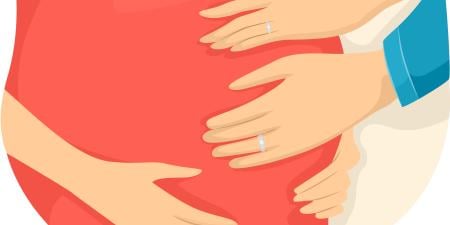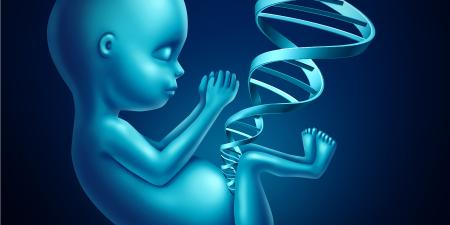Bos H, van Balen F. Children of the new reproductive technologies: social and genetic parenthood. Patient Educ Couns. 2010;81(3):429-435.
Reproductive technologies have provided infertile couples, gay couples, and single women with the opportunity to bear children. As this Bos and van Balen article describes, families in which only one parent is genetically related to the children are increasingly popular, particularly among lesbian couples and single women who seek pregnancy by artificial insemination with donated semen (AID) [1].
The Bos and van Balen review “Children of the New Reproductive Technologies: Social and Genetic Parenthood” responds to some observers’ concerns about the quality of the parent-child relationship in such families [2, 3]. These commentators suggest that the social parent—the parent who is not genetically related to the child—may feel more distant from the child than the genetic parent and hence have a less intimate parent-child relationship. Communication and trust may be hindered when the parents have not informed a child about the circumstances of birth, while children who know that they are unrelated to one parent may experience identity conflicts that interfere with their psychosocial adjustment. In addition, some worry that single mothers may face difficulties rearing a child without the support of a partner [4].
The review by Bos and van Balen challenges those concerns. They cite nine European studies [5-13] that, taken together, suggest that the parent-child relationship is even stronger in families with only one genetic parent than in “natural-conception families,” and that the psychological adjustment of children with one genetic parent is unaffected [14]. The studies found that heterosexual parents who had children using AID or oocyte donation were more involved, competent, and warmer, that they took more pleasure in childrearing, and that their children’s psychosocial adjustment was comparable to that of other children. The parental effect was not merely limited to the genetic parent; in both AID families (in which the father is the social parent) and oocyte-donation families (in which the mother is the social parent), both the social and genetic parents were more invested in childrearing than the parents of children conceived without medical assistance. The review article suggests that this difference may be due to the extra burdens experienced by these parents in their efforts to achieve parenthood [14]. Moreover, couples who cannot reproduce without assistance would be unlikely to seek technologic help if they were not particularly enthusiastic about parenting [14].
The review article cites other studies [15, 16] that report evidence that mothers in father-absent families (i.e., lesbian and single mothers) are more emotionally involved with their offspring and that their children felt more securely attached to the mother than in father-present families. Although children in these families were reported to have slower cognitive and physical development at age 6, this difference from children conceived without assistance disappeared by age 12, and they showed relatively low levels of anxiety, depression, hostility, and alcohol abuse at age 19 [17]. Gay and lesbian couples share responsibility for childcare more fairly than do heterosexual couples, making them happier with the division of childrearing [14]. For families with gay fathers, there are no differences in the child’s psychosocial adjustment from children conceived without assistance [18].
Evidence from this overview suggests that social parents and single AID mothers are no less capable and invested in childrearing than parents who conceived their children without assistance, nor do their children generally face more difficulties in psychosocial development. However, this does not imply that social parenthood brings no particular difficulties. A survey of social parents in AID families revealed that, because social parents are not recognized as legal parents in some states, they face disadvantages in certain situations such as custody disputes [19]. Another study Bos and van Balen cite found that single mothers often expressed concern about their children growing up without fathers and felt they needed to find a male role model for their children [20].
Some of the article’s conclusions should be interpreted cautiously. While the authors point to one study that found children with surrogate mothers showed no difference in psychosocial development from sexually conceived children at age three, another study found that children born of surrogate mothers faced greater adjustment difficulties at age seven [21]. The latter study hypothesized that a genetic surrogate mother who remains in contact with the family rearing the child may undermine family relationships and that a seven-year-old child would understand biological inheritance and perhaps feel the absence of a biological connection to his or her social parents—factors that would not be captured at age three. Thus, while the Bos and van Balen review presents considerable evidence that social parenthood or the absence of a father is not an inherent disadvantage in parent-child relationships and child development, it may not reveal important factors that impact childrearing or child development in certain situations.
As Bos and van Balen describe, future research should examine factors that influence childrearing quality and psychosocial adjustment in families engaging in reproductive treatment. Researchers might, for example, study perceptions of AID children by their peers and teachers and examine how social stigma may hinder psychosocial development. Future studies should also clarify whether the difficulty of obtaining reproductive donations in fact accounts for the difference in parental motivation between parents who use them and parents who can reproduce without using them, which implies that one might expect to see a decrease in parental warmth when the barriers and costs of reproductive treatment are lower. Larger sample sizes and more controlled conditions may be needed to tease out smaller differences between particular family structures. Greater research into new family models facilitated by reproductive technology will ensure that prospective parents can be fully informed in their decision to raise children and be prepared for any difficulties that they or their children may face.
References
- Bos H, van Balen F. Children of the new reproductive technologies: social and genetic parenthood. Patient Educ Couns. 2010;81(3):429-435.
-
Baran A, Pannor R. Lethal Secrets. New York, NY: Amistad; 1993.
-
Clamar A. Psychological implication of the anonymous pregnancy. In: Offerman-Zuckerberg J, ed. Gender in Transition: A New Frontier. New York, NY: Plenum; 1989.
-
Bos, van Balen, 430.
- Golombok S, Cook R, Bish A, Murray C. Families created by the new reproductive technologies: quality of parenting and social and emotional development of the children. Child Dev. 1995;66(2):285-298.
- Brewaeys A, Ponjaert I, van Hall EV, Golombok S. Donor insemination: child development and family functioning in lesbian mother families. Hum Reprod. 1997;12(6):1349-1359.
- Golombok S, Brewaeys A, Cook R, et al. The European study of assisted reproduction families: family functioning and child development. Hum Reprod. 1996;11(10):2324-2331.
- Golombok S, MacCallum F, Goodman E, Rutter M. Families with children conceived by donor insemination: a follow-up at age twelve. Child Dev. 2002;73(3):952-968.
- Golombok S, Brewaeys A, Giavazzi MT, et al. The European study of assisted reproduction families: the transition to adolescence. Hum Reprod. 2002;17(3):830-840.
- Golombok S, Lycett E, MacCallum F, et al. Parenting infants conceived by gamete donation. J Fam Psychol. 2004;18(3):443-452.
- Golombok S, Jadva V, Lycett E, et al. Families created by gamete donation: follow-up at age 2. Human Reprod. 2005;20(1):286-293.
- Golombok S, Murray C, Jadva V, Lycett E, MacCallum F, Rust J. Non-genetic and non-gestational parenthood: consequences for parent-child relationships and the psychological well-being of mothers, fathers and children at age 3. Hum Reprod. 2006;21(7):1918-1924.
- Kovacs GT, Mushin D, Kane H, Baker HW. A controlled study of the psycho-social development of children conceived following insemination with donor semen. Hum Reprod. 1993;8(5):788-790.
-
Bos, van Balen, 433.
- Golombok S, Tasker F, Murray C. Children raised in fatherless families from infancy; family relationships and the socioemotional development of children of lesbian and single heterosexual mothers. J Child Psychol Psychiat. 1997;38(7):783-791.
- MacCallum F, Golombok S. Children raised in fatherless families from infancy: a follow-up of children of lesbian and single heterosexual mothers at early adolescence. J Child Psychol Psychiat. 2004;45(8):1407-1419.
- Golombok S, Badger S. Children raised in mother-headed families from infancy: a follow-up of children of lesbian and single heterosexual mothers, at early adulthood. Hum Reprod. 2010;25(1):150-157.
-
Bos H, van Balen F. Planned gay father families in a kinship arrangement. Paper presented at: International Conference on LGBT Human Rights; 2009; Copenhagen, Denmark.
- Frith L, Sawyer N, Kramer W. Forming a family with sperm donation: a survey of 244 non-biological parents. Reprod Biomed Online. 2012;24(7):709-718.
- Jadva V, Badger S, Morrissette M, Golombok S. “Mom by choice, single by life’s circumstance…” Findings from a large scale survey of the experiences of single mothers by choice. Hum Fertil (Camb). 2009;12(4):175-184.
- Golombok S, Blake L, Casey P, Roman G, Jadva V. Children born through reproductive donation: a longitudinal study of psychological adjustment. J Child Psychol Psychiatr. 2013;54(6):653-660.



